Assessment Task 2: Indigenous Cultural Awareness Training Project Plan
VerifiedAdded on 2020/04/07
|18
|4298
|50
Project
AI Summary
This project plan outlines an Indigenous Cultural Awareness Training project designed for Central Queensland University (CQU). The project aims to enhance the cultural understanding of staff and students regarding Aboriginal and Torres Strait Islander culture, language, and heritage. The plan includes a project description, stakeholder analysis (categorizing stakeholders as Governance, Managerial, and Operational), and an assessment matrix. It addresses requirements management, including the appropriateness of stakeholders, opening statement styles, gathering requirements, and the MoSCoW technique. The scope of the project is defined, differentiating between in-scope and out-of-scope items, followed by a work breakdown structure (WBS) with a WBS dictionary detailing project phases, tasks, and cost estimates. Finally, the project schedule is presented, detailing activities, start and end dates, and durations for each phase, demonstrating a structured approach to project execution using MS Project principles.
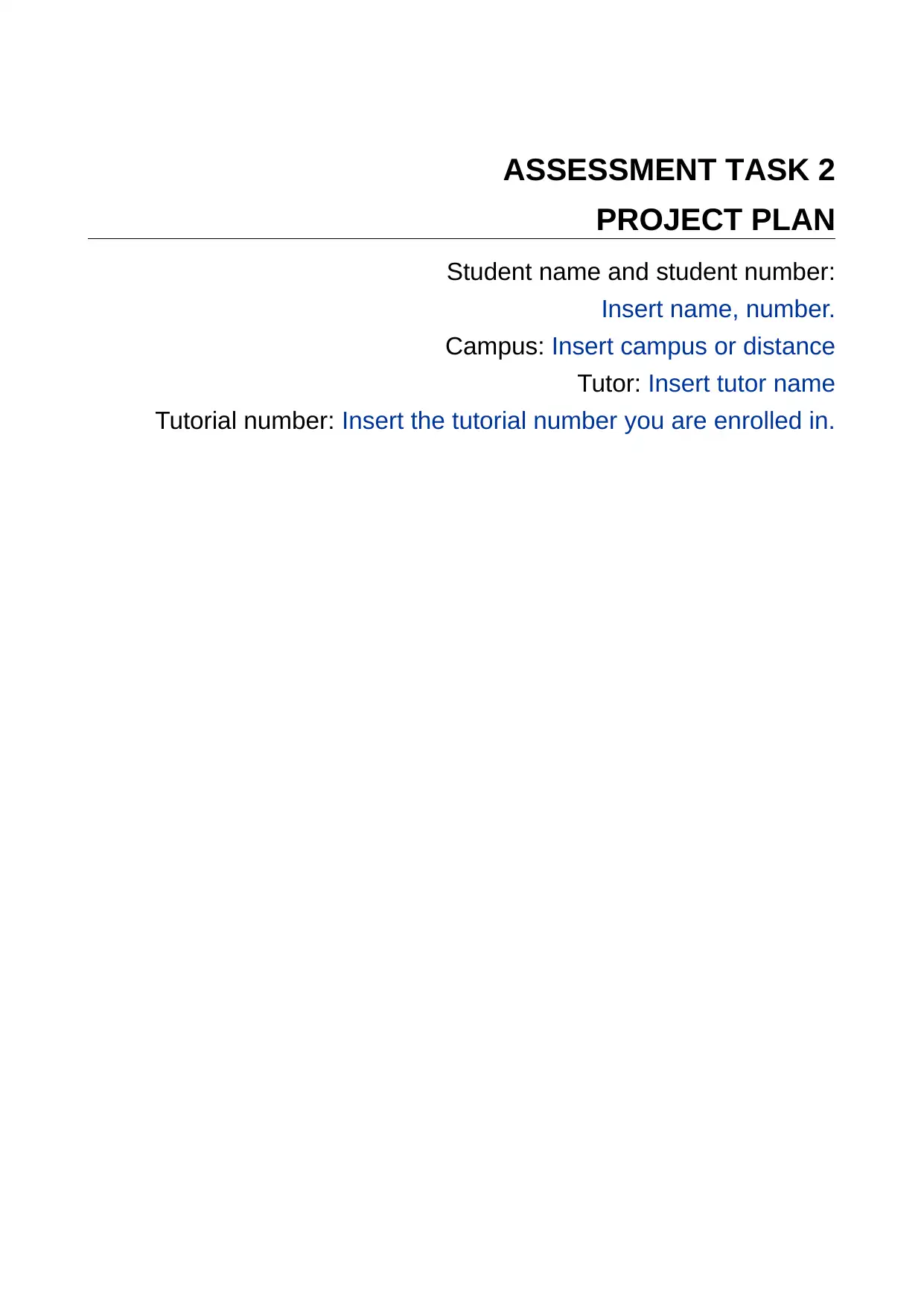
ASSESSMENT TASK 2
PROJECT PLAN
Student name and student number:
Insert name, number.
Campus: Insert campus or distance
Tutor: Insert tutor name
Tutorial number: Insert the tutorial number you are enrolled in.
PROJECT PLAN
Student name and student number:
Insert name, number.
Campus: Insert campus or distance
Tutor: Insert tutor name
Tutorial number: Insert the tutorial number you are enrolled in.
Paraphrase This Document
Need a fresh take? Get an instant paraphrase of this document with our AI Paraphraser

Notes to the Author
[This document is a template. It has been tailored to suit the assessment. All fields within the template should
be completed as per the project scenario provided.
Blue italicized text provides an explanation of what should be included for each section. Remove all
blue text prior to submission. Where there are two or more options for you to decide between,
revert the option you are keeping to black and remove the other.
[This document is a template. It has been tailored to suit the assessment. All fields within the template should
be completed as per the project scenario provided.
Blue italicized text provides an explanation of what should be included for each section. Remove all
blue text prior to submission. Where there are two or more options for you to decide between,
revert the option you are keeping to black and remove the other.
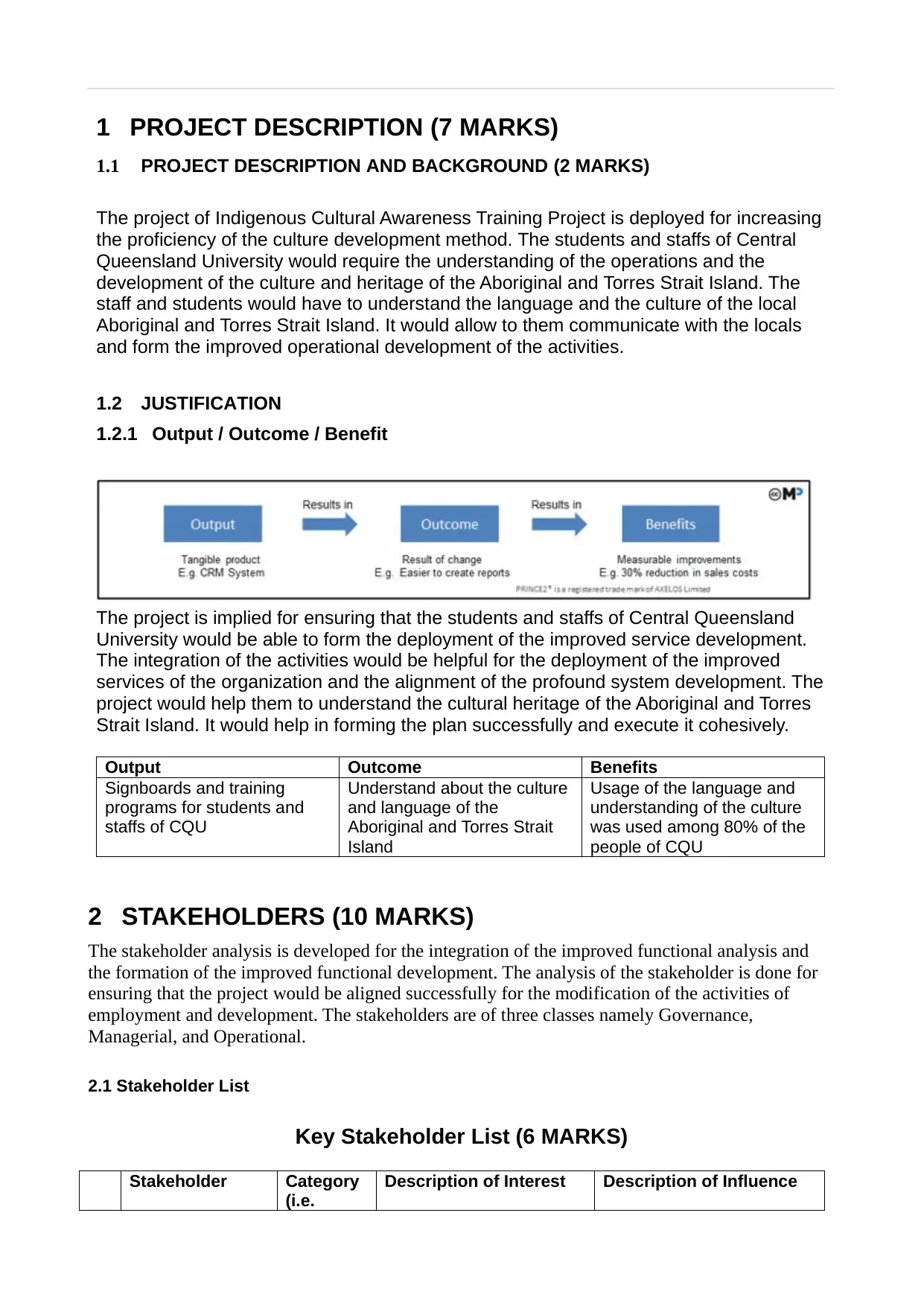
1 PROJECT DESCRIPTION (7 MARKS)
1.1 PROJECT DESCRIPTION AND BACKGROUND (2 MARKS)
The project of Indigenous Cultural Awareness Training Project is deployed for increasing
the proficiency of the culture development method. The students and staffs of Central
Queensland University would require the understanding of the operations and the
development of the culture and heritage of the Aboriginal and Torres Strait Island. The
staff and students would have to understand the language and the culture of the local
Aboriginal and Torres Strait Island. It would allow to them communicate with the locals
and form the improved operational development of the activities.
1.2 JUSTIFICATION
1.2.1 Output / Outcome / Benefit
The project is implied for ensuring that the students and staffs of Central Queensland
University would be able to form the deployment of the improved service development.
The integration of the activities would be helpful for the deployment of the improved
services of the organization and the alignment of the profound system development. The
project would help them to understand the cultural heritage of the Aboriginal and Torres
Strait Island. It would help in forming the plan successfully and execute it cohesively.
Output Outcome Benefits
Signboards and training
programs for students and
staffs of CQU
Understand about the culture
and language of the
Aboriginal and Torres Strait
Island
Usage of the language and
understanding of the culture
was used among 80% of the
people of CQU
2 STAKEHOLDERS (10 MARKS)
The stakeholder analysis is developed for the integration of the improved functional analysis and
the formation of the improved functional development. The analysis of the stakeholder is done for
ensuring that the project would be aligned successfully for the modification of the activities of
employment and development. The stakeholders are of three classes namely Governance,
Managerial, and Operational.
2.1 Stakeholder List
Key Stakeholder List (6 MARKS)
Stakeholder Category
(i.e.
Description of Interest Description of Influence
1.1 PROJECT DESCRIPTION AND BACKGROUND (2 MARKS)
The project of Indigenous Cultural Awareness Training Project is deployed for increasing
the proficiency of the culture development method. The students and staffs of Central
Queensland University would require the understanding of the operations and the
development of the culture and heritage of the Aboriginal and Torres Strait Island. The
staff and students would have to understand the language and the culture of the local
Aboriginal and Torres Strait Island. It would allow to them communicate with the locals
and form the improved operational development of the activities.
1.2 JUSTIFICATION
1.2.1 Output / Outcome / Benefit
The project is implied for ensuring that the students and staffs of Central Queensland
University would be able to form the deployment of the improved service development.
The integration of the activities would be helpful for the deployment of the improved
services of the organization and the alignment of the profound system development. The
project would help them to understand the cultural heritage of the Aboriginal and Torres
Strait Island. It would help in forming the plan successfully and execute it cohesively.
Output Outcome Benefits
Signboards and training
programs for students and
staffs of CQU
Understand about the culture
and language of the
Aboriginal and Torres Strait
Island
Usage of the language and
understanding of the culture
was used among 80% of the
people of CQU
2 STAKEHOLDERS (10 MARKS)
The stakeholder analysis is developed for the integration of the improved functional analysis and
the formation of the improved functional development. The analysis of the stakeholder is done for
ensuring that the project would be aligned successfully for the modification of the activities of
employment and development. The stakeholders are of three classes namely Governance,
Managerial, and Operational.
2.1 Stakeholder List
Key Stakeholder List (6 MARKS)
Stakeholder Category
(i.e.
Description of Interest Description of Influence
⊘ This is a preview!⊘
Do you want full access?
Subscribe today to unlock all pages.

Trusted by 1+ million students worldwide
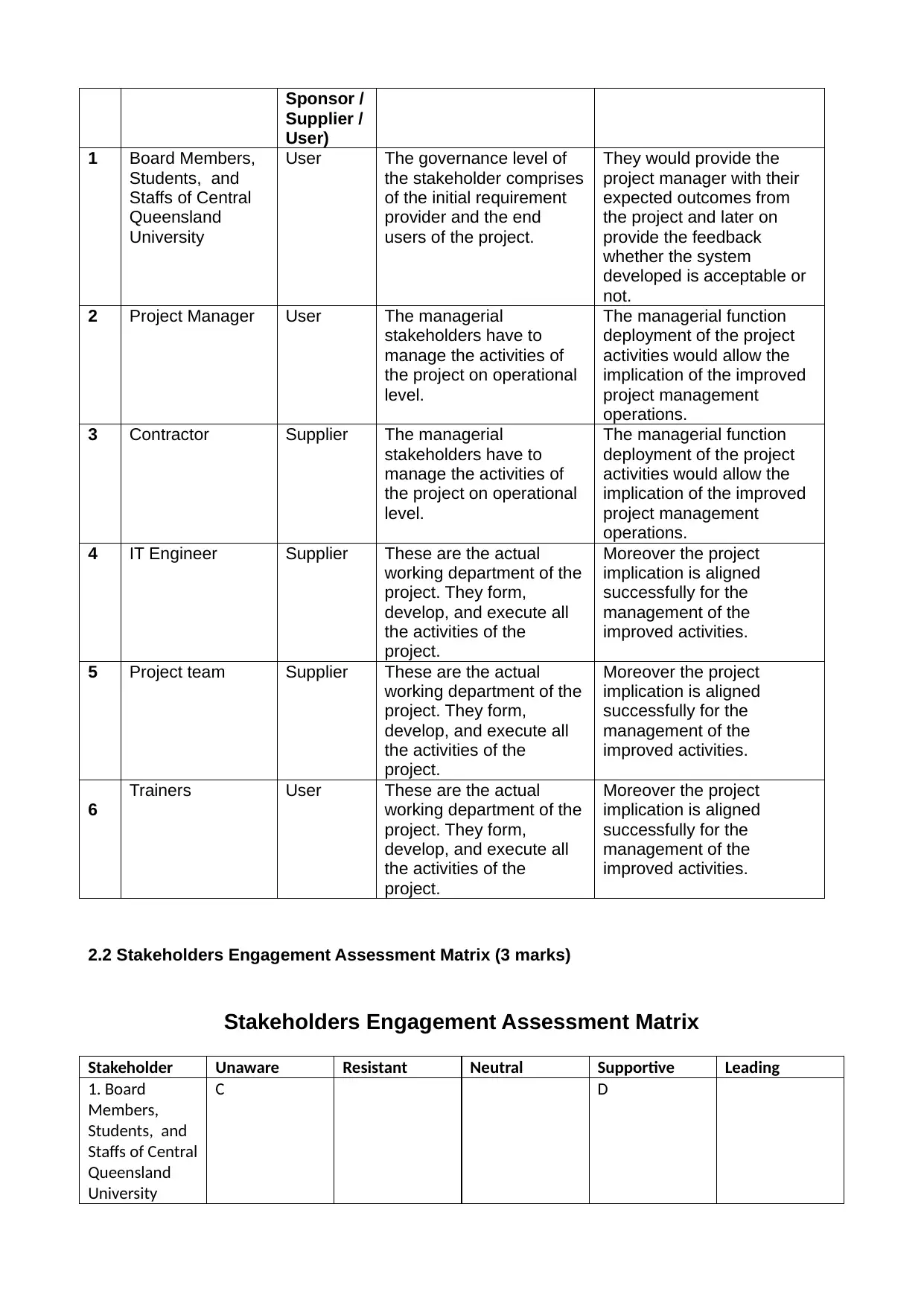
Sponsor /
Supplier /
User)
1 Board Members,
Students, and
Staffs of Central
Queensland
University
User The governance level of
the stakeholder comprises
of the initial requirement
provider and the end
users of the project.
They would provide the
project manager with their
expected outcomes from
the project and later on
provide the feedback
whether the system
developed is acceptable or
not.
2 Project Manager User The managerial
stakeholders have to
manage the activities of
the project on operational
level.
The managerial function
deployment of the project
activities would allow the
implication of the improved
project management
operations.
3 Contractor Supplier The managerial
stakeholders have to
manage the activities of
the project on operational
level.
The managerial function
deployment of the project
activities would allow the
implication of the improved
project management
operations.
4 IT Engineer Supplier These are the actual
working department of the
project. They form,
develop, and execute all
the activities of the
project.
Moreover the project
implication is aligned
successfully for the
management of the
improved activities.
5 Project team Supplier These are the actual
working department of the
project. They form,
develop, and execute all
the activities of the
project.
Moreover the project
implication is aligned
successfully for the
management of the
improved activities.
6
Trainers User These are the actual
working department of the
project. They form,
develop, and execute all
the activities of the
project.
Moreover the project
implication is aligned
successfully for the
management of the
improved activities.
2.2 Stakeholders Engagement Assessment Matrix (3 marks)
Stakeholders Engagement Assessment Matrix
Stakeholder Unaware Resistant Neutral Supportive Leading
1. Board
Members,
Students, and
Staffs of Central
Queensland
University
C D
Supplier /
User)
1 Board Members,
Students, and
Staffs of Central
Queensland
University
User The governance level of
the stakeholder comprises
of the initial requirement
provider and the end
users of the project.
They would provide the
project manager with their
expected outcomes from
the project and later on
provide the feedback
whether the system
developed is acceptable or
not.
2 Project Manager User The managerial
stakeholders have to
manage the activities of
the project on operational
level.
The managerial function
deployment of the project
activities would allow the
implication of the improved
project management
operations.
3 Contractor Supplier The managerial
stakeholders have to
manage the activities of
the project on operational
level.
The managerial function
deployment of the project
activities would allow the
implication of the improved
project management
operations.
4 IT Engineer Supplier These are the actual
working department of the
project. They form,
develop, and execute all
the activities of the
project.
Moreover the project
implication is aligned
successfully for the
management of the
improved activities.
5 Project team Supplier These are the actual
working department of the
project. They form,
develop, and execute all
the activities of the
project.
Moreover the project
implication is aligned
successfully for the
management of the
improved activities.
6
Trainers User These are the actual
working department of the
project. They form,
develop, and execute all
the activities of the
project.
Moreover the project
implication is aligned
successfully for the
management of the
improved activities.
2.2 Stakeholders Engagement Assessment Matrix (3 marks)
Stakeholders Engagement Assessment Matrix
Stakeholder Unaware Resistant Neutral Supportive Leading
1. Board
Members,
Students, and
Staffs of Central
Queensland
University
C D
Paraphrase This Document
Need a fresh take? Get an instant paraphrase of this document with our AI Paraphraser

2. Project
Manager
C D
3. Contractor C D
4. IT Engineer C D
5. Project team C D
6. Trainers C D
Manager
C D
3. Contractor C D
4. IT Engineer C D
5. Project team C D
6. Trainers C D
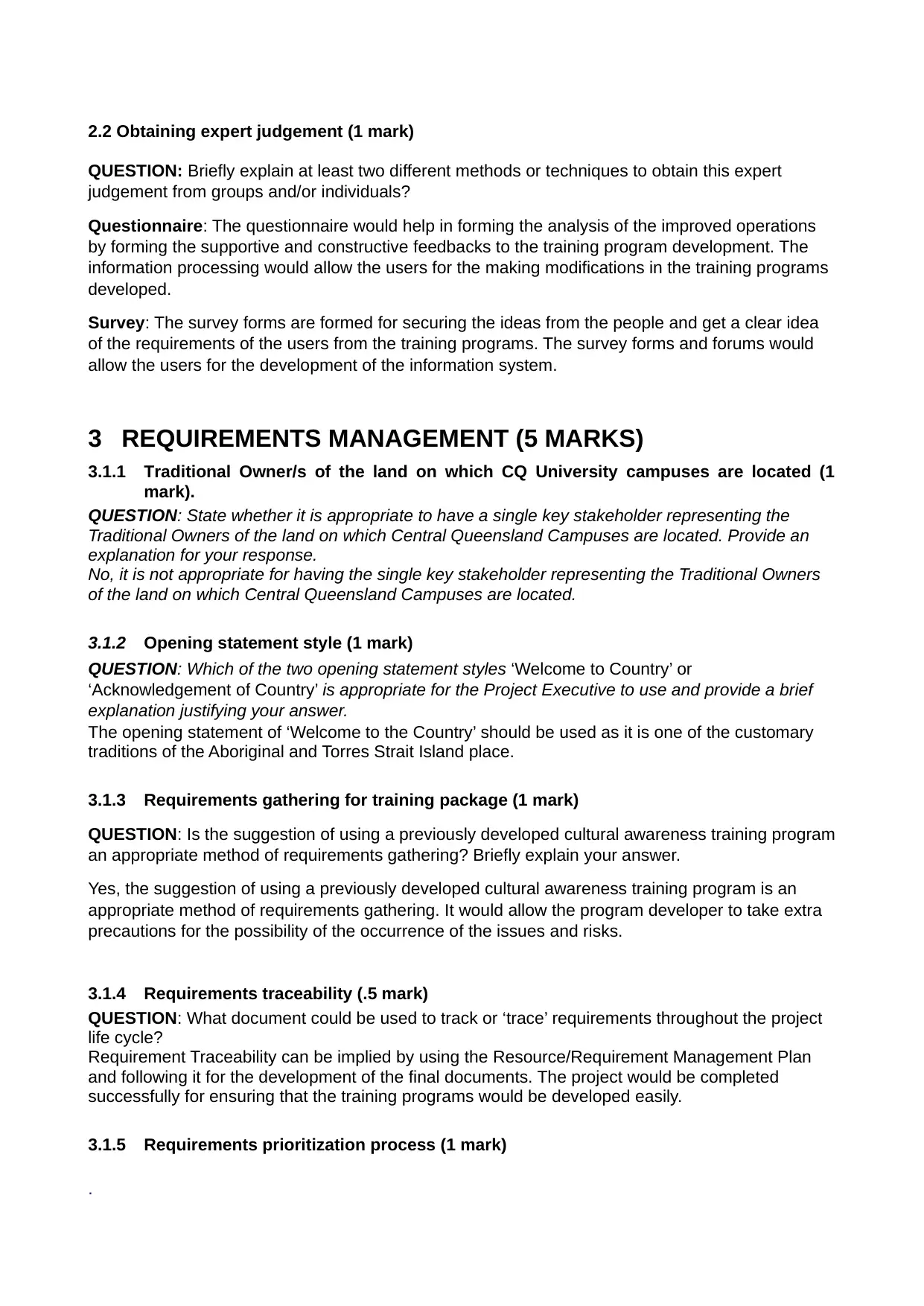
2.2 Obtaining expert judgement (1 mark)
QUESTION: Briefly explain at least two different methods or techniques to obtain this expert
judgement from groups and/or individuals?
Questionnaire: The questionnaire would help in forming the analysis of the improved operations
by forming the supportive and constructive feedbacks to the training program development. The
information processing would allow the users for the making modifications in the training programs
developed.
Survey: The survey forms are formed for securing the ideas from the people and get a clear idea
of the requirements of the users from the training programs. The survey forms and forums would
allow the users for the development of the information system.
3 REQUIREMENTS MANAGEMENT (5 MARKS)
3.1.1 Traditional Owner/s of the land on which CQ University campuses are located (1
mark).
QUESTION: State whether it is appropriate to have a single key stakeholder representing the
Traditional Owners of the land on which Central Queensland Campuses are located. Provide an
explanation for your response.
No, it is not appropriate for having the single key stakeholder representing the Traditional Owners
of the land on which Central Queensland Campuses are located.
3.1.2 Opening statement style (1 mark)
QUESTION: Which of the two opening statement styles ‘Welcome to Country’ or
‘Acknowledgement of Country’ is appropriate for the Project Executive to use and provide a brief
explanation justifying your answer.
The opening statement of ‘Welcome to the Country’ should be used as it is one of the customary
traditions of the Aboriginal and Torres Strait Island place.
3.1.3 Requirements gathering for training package (1 mark)
QUESTION: Is the suggestion of using a previously developed cultural awareness training program
an appropriate method of requirements gathering? Briefly explain your answer.
Yes, the suggestion of using a previously developed cultural awareness training program is an
appropriate method of requirements gathering. It would allow the program developer to take extra
precautions for the possibility of the occurrence of the issues and risks.
3.1.4 Requirements traceability (.5 mark)
QUESTION: What document could be used to track or ‘trace’ requirements throughout the project
life cycle?
Requirement Traceability can be implied by using the Resource/Requirement Management Plan
and following it for the development of the final documents. The project would be completed
successfully for ensuring that the training programs would be developed easily.
3.1.5 Requirements prioritization process (1 mark)
.
QUESTION: Briefly explain at least two different methods or techniques to obtain this expert
judgement from groups and/or individuals?
Questionnaire: The questionnaire would help in forming the analysis of the improved operations
by forming the supportive and constructive feedbacks to the training program development. The
information processing would allow the users for the making modifications in the training programs
developed.
Survey: The survey forms are formed for securing the ideas from the people and get a clear idea
of the requirements of the users from the training programs. The survey forms and forums would
allow the users for the development of the information system.
3 REQUIREMENTS MANAGEMENT (5 MARKS)
3.1.1 Traditional Owner/s of the land on which CQ University campuses are located (1
mark).
QUESTION: State whether it is appropriate to have a single key stakeholder representing the
Traditional Owners of the land on which Central Queensland Campuses are located. Provide an
explanation for your response.
No, it is not appropriate for having the single key stakeholder representing the Traditional Owners
of the land on which Central Queensland Campuses are located.
3.1.2 Opening statement style (1 mark)
QUESTION: Which of the two opening statement styles ‘Welcome to Country’ or
‘Acknowledgement of Country’ is appropriate for the Project Executive to use and provide a brief
explanation justifying your answer.
The opening statement of ‘Welcome to the Country’ should be used as it is one of the customary
traditions of the Aboriginal and Torres Strait Island place.
3.1.3 Requirements gathering for training package (1 mark)
QUESTION: Is the suggestion of using a previously developed cultural awareness training program
an appropriate method of requirements gathering? Briefly explain your answer.
Yes, the suggestion of using a previously developed cultural awareness training program is an
appropriate method of requirements gathering. It would allow the program developer to take extra
precautions for the possibility of the occurrence of the issues and risks.
3.1.4 Requirements traceability (.5 mark)
QUESTION: What document could be used to track or ‘trace’ requirements throughout the project
life cycle?
Requirement Traceability can be implied by using the Resource/Requirement Management Plan
and following it for the development of the final documents. The project would be completed
successfully for ensuring that the training programs would be developed easily.
3.1.5 Requirements prioritization process (1 mark)
.
⊘ This is a preview!⊘
Do you want full access?
Subscribe today to unlock all pages.

Trusted by 1+ million students worldwide

QUESTION: What is requirement prioritisation and why would it be important to communicate this
process to stakeholders?
The change controlling and the communication of the views would be carried on for ensuring that
the project is completed successfully. The requirement prioritization is a crucial factor for the
development of the improved project management operation. The project outcome is analysed and
specific conformation of the project outcome is formed. The project of Indigenous Cultural
Awareness Training Project comprises of both technological and operational activities.
3.1.6 MoSCoW Technique (.5 mark)
QUESTION: List the five components of the MoSCoW technique
Must Have: Training Program System and Manuals
Should Have: Information System
Could Have: Cloud Computing System
Won’t Have: Issues in the Engineering Process
process to stakeholders?
The change controlling and the communication of the views would be carried on for ensuring that
the project is completed successfully. The requirement prioritization is a crucial factor for the
development of the improved project management operation. The project outcome is analysed and
specific conformation of the project outcome is formed. The project of Indigenous Cultural
Awareness Training Project comprises of both technological and operational activities.
3.1.6 MoSCoW Technique (.5 mark)
QUESTION: List the five components of the MoSCoW technique
Must Have: Training Program System and Manuals
Should Have: Information System
Could Have: Cloud Computing System
Won’t Have: Issues in the Engineering Process
Paraphrase This Document
Need a fresh take? Get an instant paraphrase of this document with our AI Paraphraser
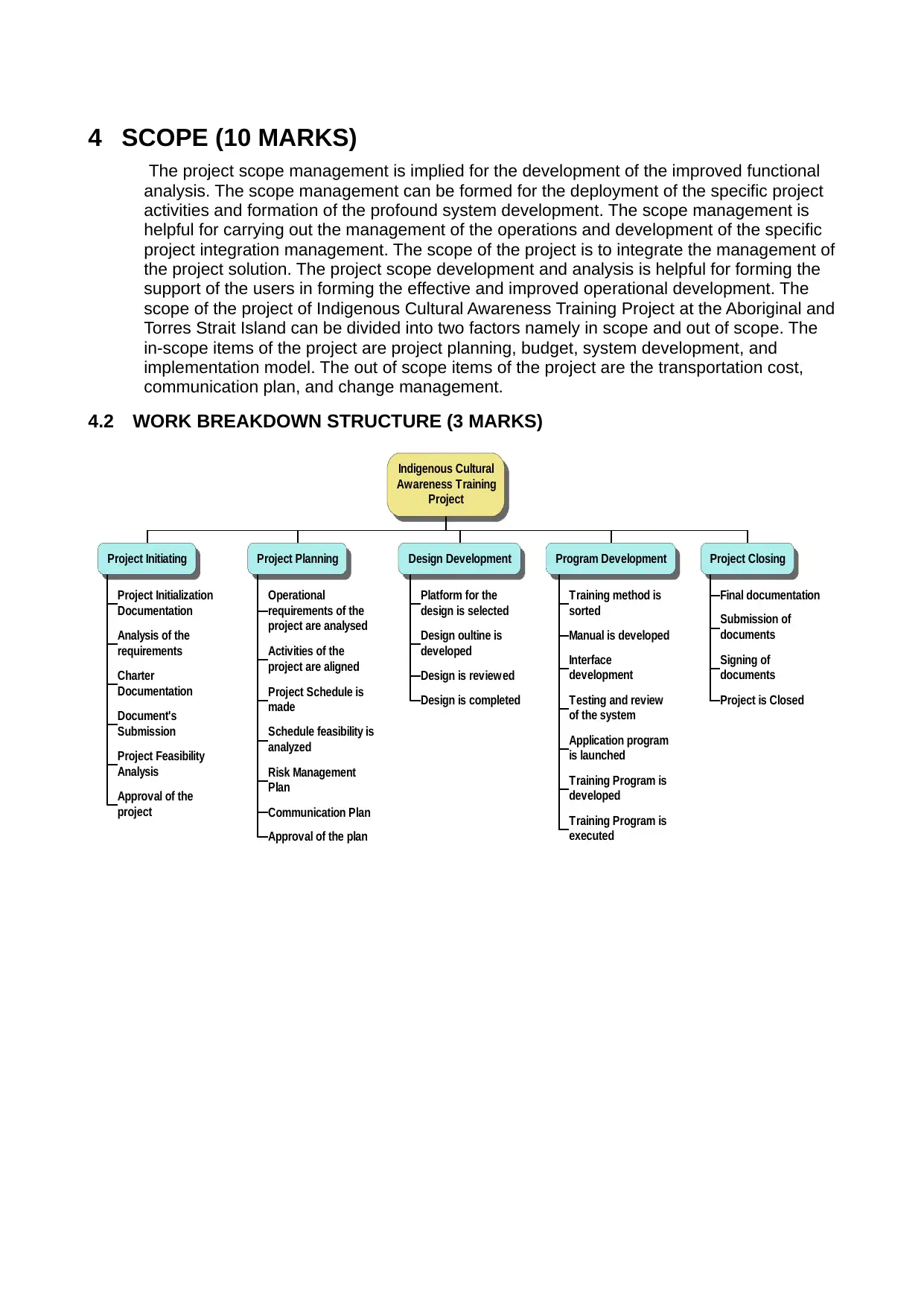
4 SCOPE (10 MARKS)
The project scope management is implied for the development of the improved functional
analysis. The scope management can be formed for the deployment of the specific project
activities and formation of the profound system development. The scope management is
helpful for carrying out the management of the operations and development of the specific
project integration management. The scope of the project is to integrate the management of
the project solution. The project scope development and analysis is helpful for forming the
support of the users in forming the effective and improved operational development. The
scope of the project of Indigenous Cultural Awareness Training Project at the Aboriginal and
Torres Strait Island can be divided into two factors namely in scope and out of scope. The
in-scope items of the project are project planning, budget, system development, and
implementation model. The out of scope items of the project are the transportation cost,
communication plan, and change management.
4.2 WORK BREAKDOWN STRUCTURE (3 MARKS)
Indigenous Cultural
Awareness Training
Project
Project Initiating
Project Initialization
Documentation
Analysis of the
requirements
Charter
Documentation
Document's
Submission
Project Feasibility
Analysis
Approval of the
project
Project Planning
Operational
requirements of the
project are analysed
Activities of the
project are aligned
Project Schedule is
made
Schedule feasibility is
analyzed
Risk Management
Plan
Communication Plan
Approval of the plan
Design Development
Platform for the
design is selected
Design oultine is
developed
Design is reviewed
Design is completed
Program Development
Training method is
sorted
Manual is developed
Interface
development
Testing and review
of the system
Application program
is launched
Training Program is
developed
Training Program is
executed
Project Closing
Final documentation
Submission of
documents
Signing of
documents
Project is Closed
The project scope management is implied for the development of the improved functional
analysis. The scope management can be formed for the deployment of the specific project
activities and formation of the profound system development. The scope management is
helpful for carrying out the management of the operations and development of the specific
project integration management. The scope of the project is to integrate the management of
the project solution. The project scope development and analysis is helpful for forming the
support of the users in forming the effective and improved operational development. The
scope of the project of Indigenous Cultural Awareness Training Project at the Aboriginal and
Torres Strait Island can be divided into two factors namely in scope and out of scope. The
in-scope items of the project are project planning, budget, system development, and
implementation model. The out of scope items of the project are the transportation cost,
communication plan, and change management.
4.2 WORK BREAKDOWN STRUCTURE (3 MARKS)
Indigenous Cultural
Awareness Training
Project
Project Initiating
Project Initialization
Documentation
Analysis of the
requirements
Charter
Documentation
Document's
Submission
Project Feasibility
Analysis
Approval of the
project
Project Planning
Operational
requirements of the
project are analysed
Activities of the
project are aligned
Project Schedule is
made
Schedule feasibility is
analyzed
Risk Management
Plan
Communication Plan
Approval of the plan
Design Development
Platform for the
design is selected
Design oultine is
developed
Design is reviewed
Design is completed
Program Development
Training method is
sorted
Manual is developed
Interface
development
Testing and review
of the system
Application program
is launched
Training Program is
developed
Training Program is
executed
Project Closing
Final documentation
Submission of
documents
Signing of
documents
Project is Closed

4.3 WBS DICTIONARY (6 MARKS)
Project Initiating
WBS ID 1
Description of work Project Initialization Documentation, Analysis of the
requirements, Charter Documentation, Document's
Submission, Project Feasibility Analysis, and Approval of
the project
Cost Estimate $4,480.00
Start and Finish Dates 1/1/18 and 1/15/18
Project Planning
WBS ID 2
Description of work Operational requirements of the project are analysed,
Activities of the project are aligned, Project Schedule is
made, Schedule feasibility is analysed, Risk Management
Plan, Communication Plan, and Approval of the plan
Cost Estimate $7,600.00
Start and Finish Dates 1/16/18 and 2/5/18
Design Development
WBS ID 3
Description of work Platform for the design is selected, Design outline is
developed, Design is reviewed, and Design is completed
Cost Estimate $5,280.00
Start and Finish Dates 2/6/18 and 2/20/18
Program Development
WBS ID 4
Description of work Training method is sorted, Manual is developed, Interface
development, Testing and review of the system,
Application program is launched, Training Program is
developed, and Training Program is executed
Cost Estimate $14,480.00
Start and Finish Dates 2/21/18 and 3/27/18
Project Initiating
WBS ID 1
Description of work Project Initialization Documentation, Analysis of the
requirements, Charter Documentation, Document's
Submission, Project Feasibility Analysis, and Approval of
the project
Cost Estimate $4,480.00
Start and Finish Dates 1/1/18 and 1/15/18
Project Planning
WBS ID 2
Description of work Operational requirements of the project are analysed,
Activities of the project are aligned, Project Schedule is
made, Schedule feasibility is analysed, Risk Management
Plan, Communication Plan, and Approval of the plan
Cost Estimate $7,600.00
Start and Finish Dates 1/16/18 and 2/5/18
Design Development
WBS ID 3
Description of work Platform for the design is selected, Design outline is
developed, Design is reviewed, and Design is completed
Cost Estimate $5,280.00
Start and Finish Dates 2/6/18 and 2/20/18
Program Development
WBS ID 4
Description of work Training method is sorted, Manual is developed, Interface
development, Testing and review of the system,
Application program is launched, Training Program is
developed, and Training Program is executed
Cost Estimate $14,480.00
Start and Finish Dates 2/21/18 and 3/27/18
⊘ This is a preview!⊘
Do you want full access?
Subscribe today to unlock all pages.

Trusted by 1+ million students worldwide
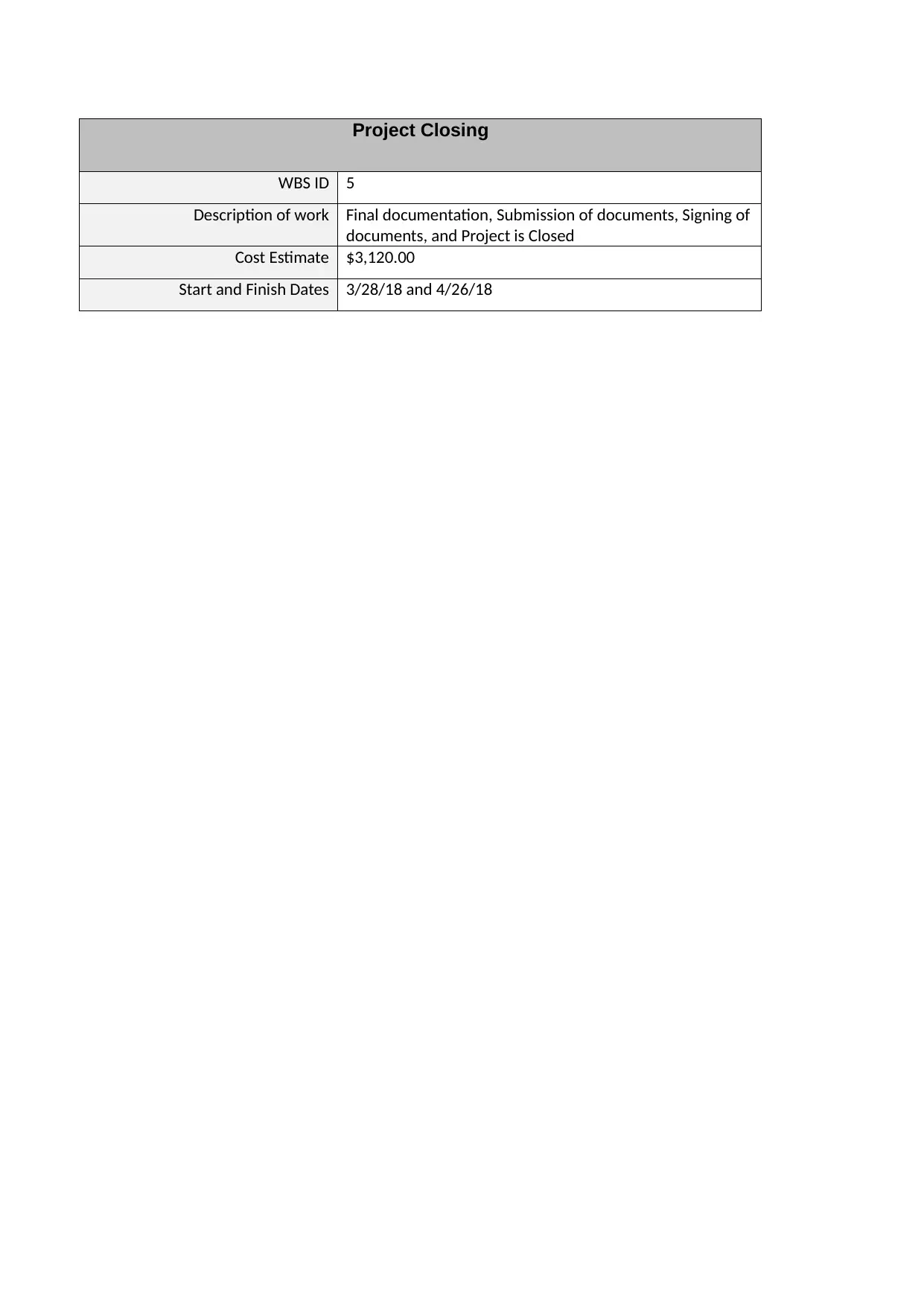
Project Closing
WBS ID 5
Description of work Final documentation, Submission of documents, Signing of
documents, and Project is Closed
Cost Estimate $3,120.00
Start and Finish Dates 3/28/18 and 4/26/18
WBS ID 5
Description of work Final documentation, Submission of documents, Signing of
documents, and Project is Closed
Cost Estimate $3,120.00
Start and Finish Dates 3/28/18 and 4/26/18
Paraphrase This Document
Need a fresh take? Get an instant paraphrase of this document with our AI Paraphraser
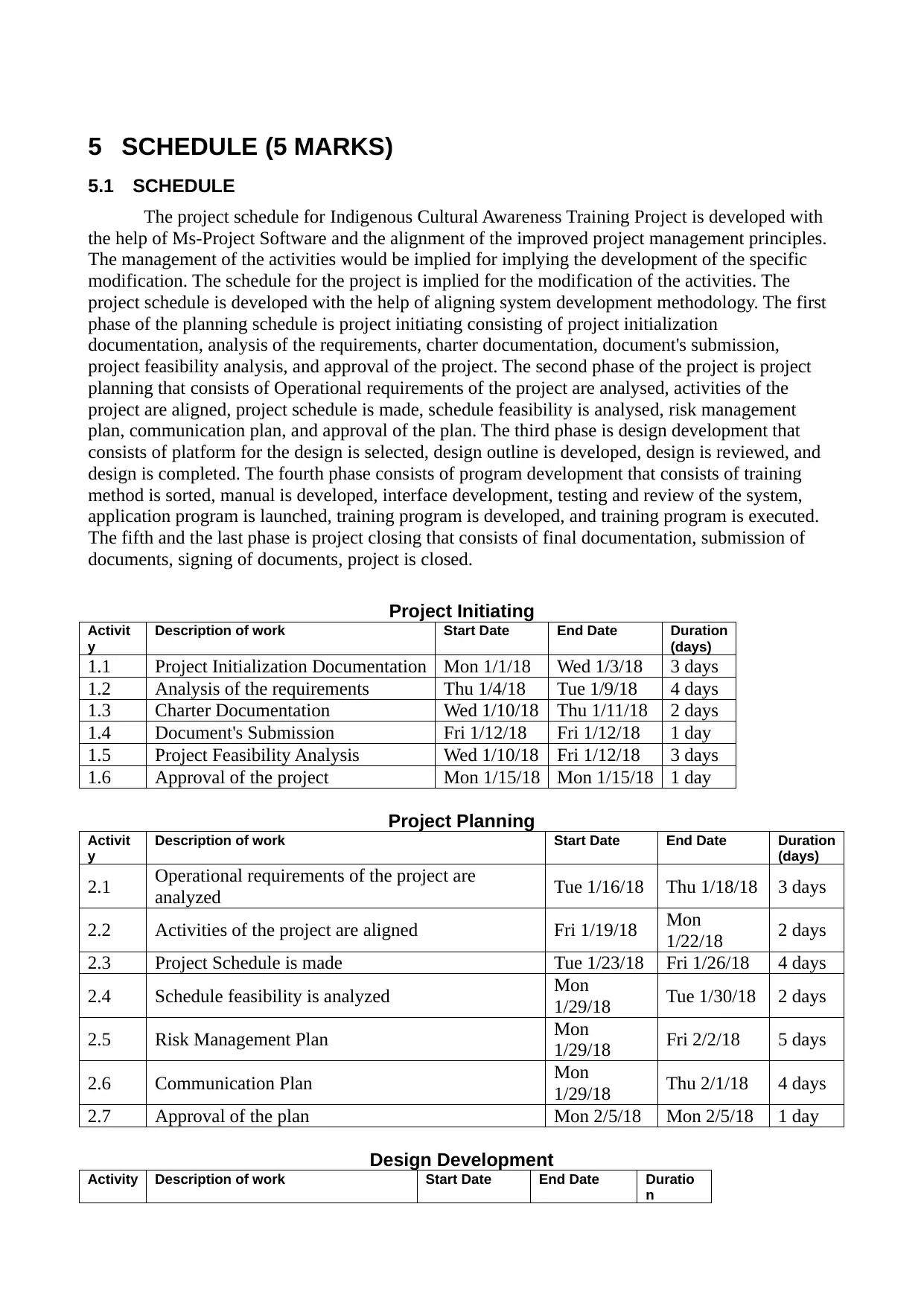
5 SCHEDULE (5 MARKS)
5.1 SCHEDULE
The project schedule for Indigenous Cultural Awareness Training Project is developed with
the help of Ms-Project Software and the alignment of the improved project management principles.
The management of the activities would be implied for implying the development of the specific
modification. The schedule for the project is implied for the modification of the activities. The
project schedule is developed with the help of aligning system development methodology. The first
phase of the planning schedule is project initiating consisting of project initialization
documentation, analysis of the requirements, charter documentation, document's submission,
project feasibility analysis, and approval of the project. The second phase of the project is project
planning that consists of Operational requirements of the project are analysed, activities of the
project are aligned, project schedule is made, schedule feasibility is analysed, risk management
plan, communication plan, and approval of the plan. The third phase is design development that
consists of platform for the design is selected, design outline is developed, design is reviewed, and
design is completed. The fourth phase consists of program development that consists of training
method is sorted, manual is developed, interface development, testing and review of the system,
application program is launched, training program is developed, and training program is executed.
The fifth and the last phase is project closing that consists of final documentation, submission of
documents, signing of documents, project is closed.
Project Initiating
Activit
y
Description of work Start Date End Date Duration
(days)
1.1 Project Initialization Documentation Mon 1/1/18 Wed 1/3/18 3 days
1.2 Analysis of the requirements Thu 1/4/18 Tue 1/9/18 4 days
1.3 Charter Documentation Wed 1/10/18 Thu 1/11/18 2 days
1.4 Document's Submission Fri 1/12/18 Fri 1/12/18 1 day
1.5 Project Feasibility Analysis Wed 1/10/18 Fri 1/12/18 3 days
1.6 Approval of the project Mon 1/15/18 Mon 1/15/18 1 day
Project Planning
Activit
y
Description of work Start Date End Date Duration
(days)
2.1 Operational requirements of the project are
analyzed Tue 1/16/18 Thu 1/18/18 3 days
2.2 Activities of the project are aligned Fri 1/19/18 Mon
1/22/18 2 days
2.3 Project Schedule is made Tue 1/23/18 Fri 1/26/18 4 days
2.4 Schedule feasibility is analyzed Mon
1/29/18 Tue 1/30/18 2 days
2.5 Risk Management Plan Mon
1/29/18 Fri 2/2/18 5 days
2.6 Communication Plan Mon
1/29/18 Thu 2/1/18 4 days
2.7 Approval of the plan Mon 2/5/18 Mon 2/5/18 1 day
Design Development
Activity Description of work Start Date End Date Duratio
n
5.1 SCHEDULE
The project schedule for Indigenous Cultural Awareness Training Project is developed with
the help of Ms-Project Software and the alignment of the improved project management principles.
The management of the activities would be implied for implying the development of the specific
modification. The schedule for the project is implied for the modification of the activities. The
project schedule is developed with the help of aligning system development methodology. The first
phase of the planning schedule is project initiating consisting of project initialization
documentation, analysis of the requirements, charter documentation, document's submission,
project feasibility analysis, and approval of the project. The second phase of the project is project
planning that consists of Operational requirements of the project are analysed, activities of the
project are aligned, project schedule is made, schedule feasibility is analysed, risk management
plan, communication plan, and approval of the plan. The third phase is design development that
consists of platform for the design is selected, design outline is developed, design is reviewed, and
design is completed. The fourth phase consists of program development that consists of training
method is sorted, manual is developed, interface development, testing and review of the system,
application program is launched, training program is developed, and training program is executed.
The fifth and the last phase is project closing that consists of final documentation, submission of
documents, signing of documents, project is closed.
Project Initiating
Activit
y
Description of work Start Date End Date Duration
(days)
1.1 Project Initialization Documentation Mon 1/1/18 Wed 1/3/18 3 days
1.2 Analysis of the requirements Thu 1/4/18 Tue 1/9/18 4 days
1.3 Charter Documentation Wed 1/10/18 Thu 1/11/18 2 days
1.4 Document's Submission Fri 1/12/18 Fri 1/12/18 1 day
1.5 Project Feasibility Analysis Wed 1/10/18 Fri 1/12/18 3 days
1.6 Approval of the project Mon 1/15/18 Mon 1/15/18 1 day
Project Planning
Activit
y
Description of work Start Date End Date Duration
(days)
2.1 Operational requirements of the project are
analyzed Tue 1/16/18 Thu 1/18/18 3 days
2.2 Activities of the project are aligned Fri 1/19/18 Mon
1/22/18 2 days
2.3 Project Schedule is made Tue 1/23/18 Fri 1/26/18 4 days
2.4 Schedule feasibility is analyzed Mon
1/29/18 Tue 1/30/18 2 days
2.5 Risk Management Plan Mon
1/29/18 Fri 2/2/18 5 days
2.6 Communication Plan Mon
1/29/18 Thu 2/1/18 4 days
2.7 Approval of the plan Mon 2/5/18 Mon 2/5/18 1 day
Design Development
Activity Description of work Start Date End Date Duratio
n

(days)
3.1 Platform for the design is selected Tue 2/6/18 Tue 2/6/18 1 day
3.2 Design outline is developed Wed 2/7/18 Fri 2/9/18 3 days
3.3 Design is reviewed Mon 2/12/18 Tue 2/13/18 2 days
3.4 Design is completed Wed 2/14/18 Tue 2/20/18 5 days
Program Development
Activit
y
Description of work Start Date End Date Duration
(days)
4.1 Training method is sorted Wed 2/21/18 Thu 2/22/18 2 days
4.2 Manual is developed Fri 2/23/18 Wed 2/28/18 4 days
4.3 Interface development Thu 3/1/18 Wed 3/7/18 5 days
4.4 Testing and review of the system Thu 3/8/18 Mon
3/12/18 3 days
4.5 Application program is launched Tue 3/13/18 Wed 3/14/18 2 days
4.6 Training Program is developed Thu 3/15/18 Thu 3/22/18 6 days
4.7 Training Program is executed Fri 3/23/18 Tue 3/27/18 3 days
Project Closing
Activity Description of work Start Date End Date Duratio
n
(days)
5.1 Final documentation Wed 3/28/18 Mon 4/2/18 4 days
5.2 Submission of documents Tue 4/3/18 Wed 4/4/18 2 days
5.3 Signing of documents Thu 4/5/18 Thu 4/5/18 1 day
5.4 Project is Closed Fri 4/6/18 Fri 4/6/18 1 day
3.1 Platform for the design is selected Tue 2/6/18 Tue 2/6/18 1 day
3.2 Design outline is developed Wed 2/7/18 Fri 2/9/18 3 days
3.3 Design is reviewed Mon 2/12/18 Tue 2/13/18 2 days
3.4 Design is completed Wed 2/14/18 Tue 2/20/18 5 days
Program Development
Activit
y
Description of work Start Date End Date Duration
(days)
4.1 Training method is sorted Wed 2/21/18 Thu 2/22/18 2 days
4.2 Manual is developed Fri 2/23/18 Wed 2/28/18 4 days
4.3 Interface development Thu 3/1/18 Wed 3/7/18 5 days
4.4 Testing and review of the system Thu 3/8/18 Mon
3/12/18 3 days
4.5 Application program is launched Tue 3/13/18 Wed 3/14/18 2 days
4.6 Training Program is developed Thu 3/15/18 Thu 3/22/18 6 days
4.7 Training Program is executed Fri 3/23/18 Tue 3/27/18 3 days
Project Closing
Activity Description of work Start Date End Date Duratio
n
(days)
5.1 Final documentation Wed 3/28/18 Mon 4/2/18 4 days
5.2 Submission of documents Tue 4/3/18 Wed 4/4/18 2 days
5.3 Signing of documents Thu 4/5/18 Thu 4/5/18 1 day
5.4 Project is Closed Fri 4/6/18 Fri 4/6/18 1 day
⊘ This is a preview!⊘
Do you want full access?
Subscribe today to unlock all pages.

Trusted by 1+ million students worldwide
1 out of 18
Related Documents
Your All-in-One AI-Powered Toolkit for Academic Success.
+13062052269
info@desklib.com
Available 24*7 on WhatsApp / Email
![[object Object]](/_next/static/media/star-bottom.7253800d.svg)
Unlock your academic potential
Copyright © 2020–2025 A2Z Services. All Rights Reserved. Developed and managed by ZUCOL.





